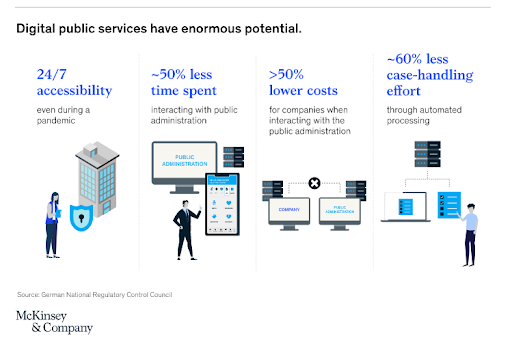What you need to know:
- Challenges and opportunities of digital transformation for government organizations include integrating system-of-record data securely and compliantly, implementing an easy-to-use GovTech platform and leveraging unified data
- Transforming public service delivery will bring the opportunities to boost operational efficiencies, cost savings, improved public and employee safety and better citizen and employee experiences
- Scalable technology, security, customization and analytics are fundamental to successful government digital transformations
Governments face multiple digital transformation challenges
Citizen development is fundamental to digital transformation. One of the first steps in any organization’s digital transformation is identifying the services that they want to digitize. In government, each service that a citizen accesses can be described as a journey, similar to the “customer journey” in business.
For example, applying for a driver’s license, paying a parking ticket, renewing a toll tag and requesting a copy of a birth certificate are all citizen journeys that government agencies are responsible for enabling. Digitizing so many journeys can be a much bigger challenge for government than for businesses, according to McKinsey:
“Private-sector organizations typically manage just a few customer journeys. Governments, by contrast, are responsible for 50 to 100 journeys, which account for thousands of individual services.”
McKinsey,Digital public services: How to achieve fast transformation at scale
Because even a small local government can be responsible for dozens of citizen journeys, it’s wise to prioritize the services that citizens use the most for digitization first. Other journeys can be added to the digital menu later on.
To digitize those first high-priority services—and to make it easier to add more digital services later in the transformation—governments face another big task: getting all their data out of silos and into a single source. This requires integrating data from systems of record into a unified digital database that complies with government security and data-access standards.
Because each system of record may have its own way of classifying and storing data, most digital transformations require extensive data cleanup and standardization for the new unified system to work properly.
“Only 45 percent of developers agreed that government data was clean and accurate; the same percent agreed that it was in a usable format for their work.”
Managing all this data so that it’s fully integrated, compliant and secure requires guidance from experts who are experienced with legacy government software, who understand the compliance and the security requirements government agencies must follow and who have access to the technical tools and resources to meet those requirements.
Another factor affecting digital transformation is selecting a platform that works for agency leaders and employees as well as for the citizens they serve. A good platform will:
- Be easy and intuitive for constituents to use, with conversational chatbots, simple navigation and clear content to make the user journey simple and quick
- Give employees real-time visibility into accounts and payments, so they can give citizens accurate answers to their questions and avoid sending out bills or warrants for items that have already been paid
- Allow for access on any type of device, so citizens can take care of bills and other tasks at their convenience
- Automate payment processing, reporting and reconciliation for faster time to revenue and less employee time spent on payments
- Analyze data and create reports to use in budget and service planning, compliance reporting and citizen experience improvement
- Offer easy customization so agencies can add new services or update messaging as efficiently as possible
Like with integration, platform selection and configuration require expertise and guidance from a team that’s experienced in serving government organizations.
All of this may sound like a lot of effort, but the benefits of government digital transformation are worth the effort.
Digital transformation initiatives creates opportunities for governments
For government financial officers and local governments on limited budgets, one of the most appealing benefits of digital transformation efforts is the potential for cost savings. For example, McKinsey has shared findings from German government analysts that digital services can dramatically reduce employee time and costs related to basic interactions while increasing public access to government services.

PayIt clients have found similar efficiency improvements after adding or optimizing digital access to their services. The North Carolina Department of Motor Vehicles, for example, found that in-office wait times dropped by 40% after a number of initiatives that focused on driving customers online and improving in-person operations.
Convenient digital payment options can increase online revenue collection while also increasing on-time payments and reducing manual bookkeeping tasks. For example:
- In North Carolina, online revenue collection through myNCDMV increased by 25% between Q1 2020 and Q1 2021
- In Beaufort County, South Carolina, digital payment options cut the number of paper checks employees had to process by 35%, while raising the county’s property tax collection rate “higher than it has ever been”
- Automated payment reconciliation and reporting built into a digital payment portal can save employees several hours a week on these tasks, and it can eliminate the chance of human error
A digital portal also enables C2G (citizen to government) communication, improving public sector efficiency when there’s important news to share, whether that’s a simple change in office hours or an emergency. For example, officials were able to leverage myNCDMV to reach nearly 500,000 citizens with information about how to safely renew their tags, registrations and licenses while DMV offices were closed during the pandemic.
The same technology can be used by public services to combat misinformation and keep the public informed during power outages, storms, earthquakes and other situations where citizens need reliable, clear safety information delivered in real time.
Another benefit of embracing the digital transformation is greater accessibility for residents who lack transportation for in-person visits or who live with disabilities that make it difficult or impossible to travel to government offices.
Successful digital transformation supports more citizen engagement
With a unified digital portal in place, state agencies and local governments can add access to more services over time—even services provided by different government departments or entities. These steps toward “one-stop shop” government services create more convenience for constituents and more efficiency for governments—and they can help more citizens to engage with their government digital services and the democratic process.
For example, North Carolina’s vehicle registration and driver’s license services platform, myNCDMV, added voter registration and voter change of address abilities to its portal in April 2020. After that update, the online DMV app became the most common way for new voters to register, based on data comparing April-December 2020 registration sources to the same period in 2019.
In addition to greater convenience, the online voter registration option helped to protect both public health and civic involvement when in-person voter registration drives and DMV office access were curtailed in many areas because of the pandemic. myNCDMV offers a strong example of how digital transformation can help governments and the citizens they serve to pivot when conditions change.
Meet the challenges and accelerate your government digital transformation
We’ve helped local and state governments create streamlined, secure digital experiences for more than 80 million citizens—and we’ve earned some serious recognitions and awards for our work along the way.
We’re ready to help your organization clear the hurdles to a smooth digital transformation. Request your customized PayIt demo today and learn what we can do for you.
